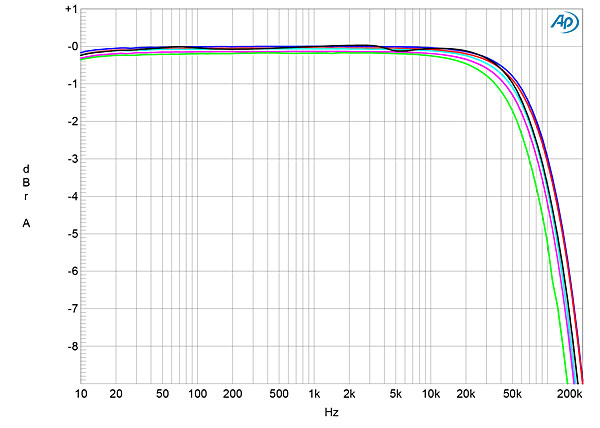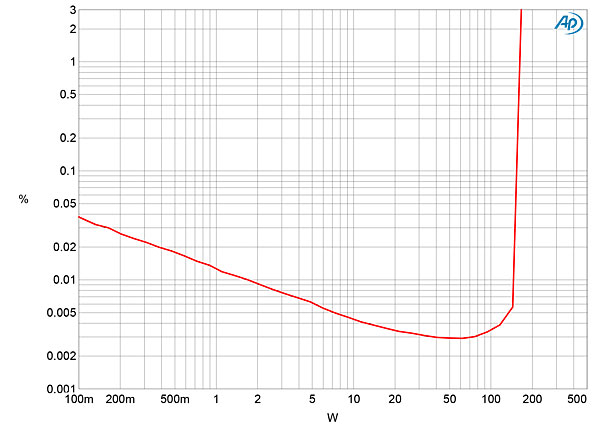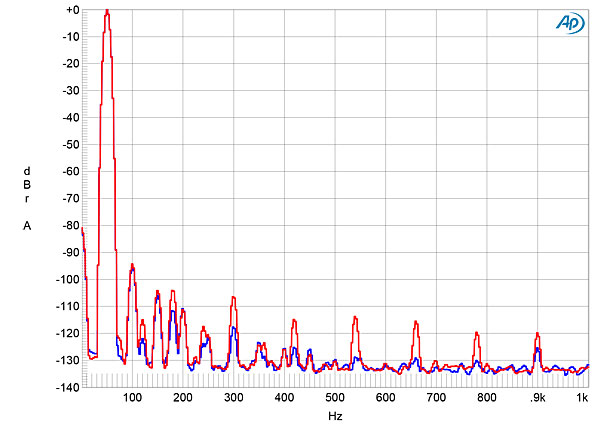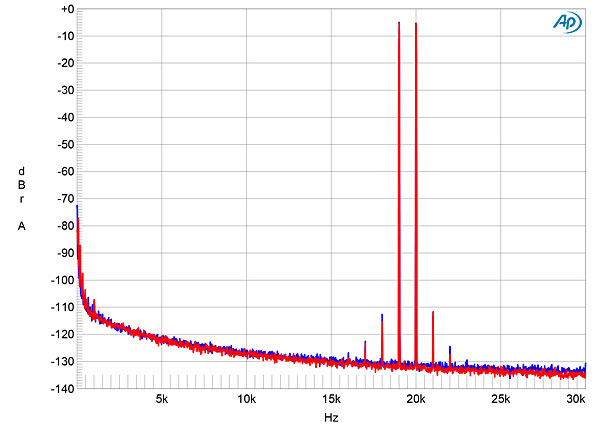| Columns Retired Columns & Blogs |
This is a good looking machine, but quite costly.
I measured the Luxman L-509X using my Audio Precision SYS2722 system (see the January 2008 "As We See It"). Before I test an amplifier, I precondition it with both channels driving a 1kHz tone at one-third power into 8 ohms for an hour. At the end of that time, the Luxman's top panel was warm, at 95°F (35°C), and the small metal grilles above the heatsinks were hotter, at 107.7°F (42.1°C).
Looking first at the line inputs: The maximum voltage gain at 1kHz from the speaker terminals into 8 ohms, with the volume control set to the maximum, measured 43.4dB for both balanced and unbalanced signals. The meters on the amplifier's front panel appear to be calibrated so that "–20dB" corresponds to just over 1W into 8 ohms. With the rear-panel switch set to Normal, the balanced inputs inverted absolute polarity, meaning that the XLR jacks are wired with pin 3 hot, which the manual confirms. The polarity can be changed to pin 2 hot with the switch. The unbalanced inputs preserved absolute polarity (ie, were non-inverting). The unbalanced input impedance was a relatively high 47k ohms at 20Hz and 1kHz, decreasing slightly at 20kHz to a still-high 36k ohms. The balanced input impedance was 52k ohms from 20Hz to 20kHz.
The headphone output impedance was very high, at 800 ohms at all audio frequencies. As the maximum gain at this output was the same as at the speaker terminals, I suspect that the headphone output is implemented by placing a resistor in series with the power-amplifier stage. The output impedance at the speaker terminals was a very low 0.075 ohm at low and middle frequencies, rising to 0.11 ohm at the top of the audioband. As a result, the modulation of the L-509X's frequency response with our standard simulated loudspeaker was less than ±0.1dB (fig.1, gray trace). This graph was taken with the tone controls defeated and with the volume control set to its maximum; commendably, there was no change in response at lower volume-control settings. The Luxman's frequency response is down by 3dB at 100kHz; as a result, a 10kHz squarewave was reproduced with very short risetimes (fig.2), and there was no overshoot or ringing with a resistive load.


The Bass and Treble controls offered maximum cuts and boosts of 9dB, but with a slight difference between the channels (fig.3). It turned out that when I enabled the tone controls, that also activated the Balance control, which was slightly favoring the right channel. With the Balance control centered, channel separation was good rather than great, at 75dB in both directions. The unweighted, wideband signal/noise ratio was 75.4dB, this improving to a respectable 82.6dB when the measurement bandwidth was restricted to 22Hz–22kHz, and to 85.7dB with an A-weighting filter in circuit. Spectral analysis of the low-frequency noise floor (fig.4) indicated that all the AC-supply harmonics lay below –95dB.


Luxman specifies the L-509X as offering 120Wpc into 8 ohms (20.8dBW) and 220Wpc into 4 ohms (20.4dBW), and the amplifier comfortably exceeded its specified power even with both channels driven. With clipping defined as when the THD+noise in the output reaches 1%, I measured clipping powers of 154Wpc into 8 ohms (21.9dBW, fig.5) and 250Wpc into 4 ohms (21dBW, fig.6). The downward slope of the traces in these graphs indicates that the distortion lies beneath the noise floor below 50W or so. To be certain I was measuring actual distortion, I examined how the THD+N percentage varied with frequency at a fairly high level, 20V (equivalent to 50W into 8 ohms and 100W into 4 ohms). Even so, the THD+N was extremely low in the bass and midrange, and while there was the usual rise in the treble, this was still not to a significant amount (fig.7).



The THD+N waveform at this level (fig.8) indicates that the distortion is predominantly second-harmonic in nature, this confirmed by spectral analysis (fig.9), though at high powers into 4 ohms the third harmonic became the highest in level in the left channel (fig.10, blue trace). Tested with an equal mix of 19 and 20kHz tones, the Luxman produced relatively low levels of intermodulation distortion, even at high powers into low impedances (fig.11), with the difference product at 1kHz lying at –100dB (0.001%), and the higher-order products at or below –80dB (0.01%).




The Luxman L-509X's phono input offers two modes, for moving-magnet and moving-coil cartridges. Both modes preserved absolute polarity. The gain in MM mode was 79.5dB, measured at the speaker terminals with the volume control set to its maximum, and 35.6dB when measured at the Rec Out jacks. In MC mode, the gain was 53.1dB, again measured at the Rec Out jacks. The MM input impedance was 45k ohms at low and middle frequencies, 37k ohms at 20kHz. The MC mode impedance was a constant 100 ohms across the audioband.
The RIAA error was low, with a slight, +0.4dB bump in the midrange (fig.12). However, the left channel (blue trace) has a slight boost in the top audio octaves. Noise levels were low, and in MM mode, the unweighted, wideband S/N ratio was an excellent 69dB ref. 1kHz at 5mV, this improving to 90.6dB when A-weighted. In MC mode, the unweighted, wideband S/N ratio was a still-good 65dB. Phono overload margins were excellent, at 25dB across the audioband in MM mode, 30dB in MC mode. Harmonic and intermodulation distortion levels via the phono input were also superbly low (figs.13 & 14).



Its measured performance indicates that Luxman's L-509X integrated amplifier is a conservatively engineered design, with low noise and distortion and an excellent phono stage.—John Atkinson

This is a good looking machine, but quite costly.

Excellent review -KM.
A beautiful amp.

I'll echo the first two comments; this is a gorgeous machine. Dare I say my Yamaha as2100 is not too dissimilar.

... "happily live with the Luxman L-509X till kingdom come", before reaching that sort of decision I'd first want to compare this Luxman amp to the Accuphase E-470.
http://www.accuphase.com/model/e-470.html

Could this be compared to the new Accuphase E-650 integrated, or is it more along the lines of the Accuphase E-470?

For that kind of money you should either be able to buy a good used car or a really nice amp. I wonder just how much of an amp you're getting for you money here. I'm sure it's a good sounding amp, but does it have the reserve that an amp in this price range should have. It only draws 380 watts. Even a cheap Onkyo draws more power than that..

Am wondering if JA got the MM & MC gain figures transposed? 79.5db for MM is very high and 53.1db is just barely adequate for LOMCs. If they are transposed, they still remain quite high for for their intended cartridges (45db or MM and 60 for MC being more in the "usual" range).